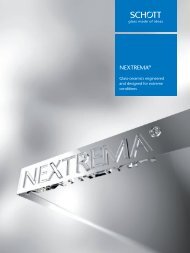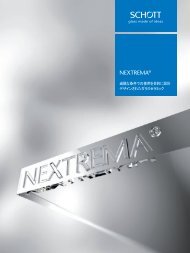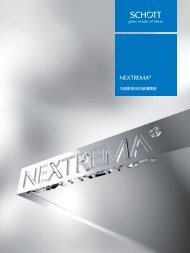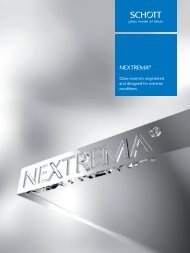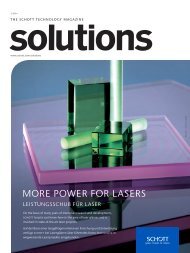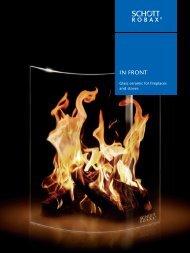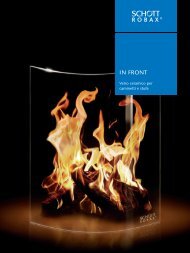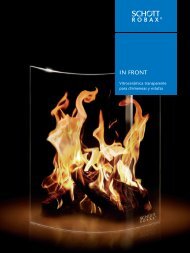SCHOTT Technical Glasses
Apart from its application in optics, glass as a technical material has exerted a formative influence on the development of important technological fields such as chemistry, pharmaceutics, automotive, optics, optoelectronics and information technology. SCHOTT Technical Glasses offers pertinent information in concise form. It contains general information for the determination and evaluation of important glass properties and also informs about specific chemical and physical characteristics and possible applications of the commercial technical glasses produced by SCHOTT. With this brochure, we hope to assist scientists, engineers, and designers in making the appropriate choice and make optimum use of SCHOTT products.
Apart from its application in optics, glass as a technical material has exerted a formative influence on the development of important technological fields such as chemistry, pharmaceutics, automotive, optics, optoelectronics and information technology. SCHOTT Technical Glasses offers pertinent information in concise form. It contains general information for the determination and evaluation of important glass properties and also informs about specific chemical and physical characteristics and possible applications of the commercial technical glasses produced by SCHOTT. With this brochure, we hope to assist scientists, engineers, and designers in making the appropriate choice and make optimum use of SCHOTT products.
You also want an ePaper? Increase the reach of your titles
YUMPU automatically turns print PDFs into web optimized ePapers that Google loves.
23<br />
Several glasses, especially glasses with low or close to zero<br />
alkaline content are good dielectrics with low loss in the<br />
GHz range. Examples are AF32, BF33, 8253. In Tab. 5, we<br />
show the dielectric loss of AF32 in the GHz range. In microwave<br />
electronics the loss if often characterized with the<br />
Q-factor Q = 1/tanδ or with Q*f (unit GHz) which is the<br />
product of the Q factor and the frequency.<br />
The steep increase in dielectric losses with increasing temperature<br />
(Figure 19) can lead to instability, i.e. to overheating<br />
of the glass due to dielectric loss energy in the case<br />
of restricted heat dissipation and corresponding electrical<br />
power.<br />
4.4 Dielectric strength<br />
<strong>Glasses</strong> that are free of inhomogeneities such as bubbles<br />
and impurities are dielectrically very stable and often outperform<br />
porous electro-ceramics.<br />
The dielectric strength of glasses depends on the frequency,<br />
the rate of increase in voltage, the temperature, the glass<br />
composition, and the external test conditions. Furthermore,<br />
the breakdown field strength increases substantially with<br />
decreasing glass thickness, indicating heat breakdown (interrelated<br />
increase in temperature and electrical conductivity) as<br />
the preferred breakdown mechanism. For ultra-thin glasses,<br />
the dielectric breakdown strength can show extremely large<br />
values. With an alkaline free glass, breakdown strength of<br />
1200 kV/mm has been measured on 12 µm thick samples.<br />
In Figure 20 we schematically show the thickness dependence<br />
of the dielectric breakdown strength of AF32. “Cold”<br />
breakdown caused by the sudden formation of an electron<br />
avalanche is technically unimportant.<br />
Approximate values for the dielectric strength of glass are<br />
field strengths of 20 – 40 kV/mm for glass thicknesses of<br />
1 mm at 50 Hz at 20 °C, and 10 – 20 kV/mm for greater thinknesses.<br />
Decreasing values can be expected at higher temperatures<br />
and frequencies.<br />
f [GHz] tanδ error ± Q error ± Qf [GHz] error ±<br />
2 0.003 0.0005 372 18 744 37<br />
5 0.004 0.0006 283 17 1416 86<br />
10 0.005 0.0006 219 16 2195 155<br />
20 0.006 0.0008 159 13 3175 258<br />
30 0.008 0.0009 125 11 3740 328<br />
50 0.012 0.0015 83 10 4161 512<br />
70 0.018 0.0026 57 11 3977 748<br />
77 0.020 0.0034 49 12 3809 913<br />
Table 5. Dielectric loss of AF32 in the GHz range<br />
4<br />
Dielectric breakdown strength for AF 32 in kV/mm ––><br />
600<br />
500<br />
400<br />
300<br />
200<br />
100<br />
Breakdown measurements on AF32<br />
0<br />
0.01 0.1<br />
1<br />
Thickness in mm ––><br />
Fig. 20. Thickness dependence of the dielectric breakdown strength<br />
of AF32<br />
Close-up of the front of an ozonizer, inside






